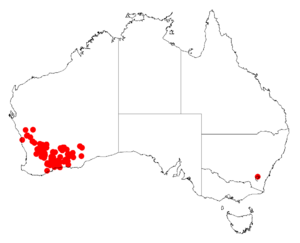Acacia chrysella facts for kids
Quick facts for kids Acacia chrysella |
|
|---|---|
| Scientific classification | |
| Genus: |
Acacia
|
| Species: |
chrysella
|
 |
|
| Occurrence data from AVH | |
Acacia chrysella is a type of shrub that belongs to the large group of plants called Acacias. It is found naturally in Western Australia. This plant is known for its dense, rounded shape and pretty yellow flowers.
Contents
What Does Acacia chrysella Look Like?
This shrub is usually dense, bushy, and rounded. It can grow to be about 0.7 to 3.5 meters (2 to 11 feet) tall. Its branches are smooth, meaning they have no hairs.
- Leaves (Phyllodes): The leaves of Acacia chrysella are actually flattened leaf stems called phyllodes. They stand upright and are long and narrow, sometimes slightly curved. Each phyllode is about 4 to 13 centimeters (1.5 to 5 inches) long. They are usually 1 to 5.5 millimeters (less than 1/4 inch) wide.
- Flowers: This plant blooms for a long time, from November to August. It produces bright yellow flowers. The flowers grow in small, round clusters called inflorescences. Each cluster is about 2 to 3 millimeters (less than 1/8 inch) across. These clusters contain 15 to 25 light golden flowers. Several of these flower clusters grow along a stem, forming a flower arrangement called a raceme.
- Seed Pods: After the flowers, the plant forms long, smooth seed pods. These pods can be up to 10 centimeters (4 inches) long and about 5 to 6 millimeters (less than 1/4 inch) wide. Inside the pods are dull black seeds. The seeds are oblong or oval-shaped and are about 4 to 6 millimeters (less than 1/4 inch) long.
How Was Acacia chrysella Named?
The plant was first officially described by two botanists, Joseph Maiden and William Blakely. They wrote about it in 1928. Their description was part of a larger work about new Acacia species from Western and Northern Australia.
Later, in 2003, another botanist named Leslie Pedley reclassified it. He moved it to a different plant group called Racosperma chrysellum. However, in 2006, it was moved back to the Acacia group.
The first official sample of this plant, called a type specimen, was collected in 1917. It was found near Merredin by Frederick Stoward.
Acacia chrysella is part of a group of similar Acacia plants. It is most closely related to species like Acacia aestivalis, Acacia brumalis, Acacia chamaeleon, and Acacia harveyi.
Where Does Acacia chrysella Grow?
This shrub is native to several regions in Western Australia. You can find it in the Great Southern, Wheatbelt, and Goldfields-Esperance areas. It grows well in different types of soil, including sandy soil, loam (a mix of sand, silt, and clay), or clay soils.
See Also
- List of Acacia species

